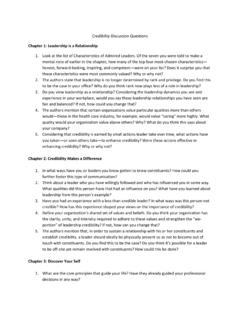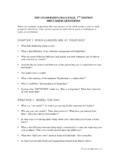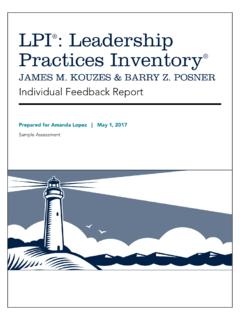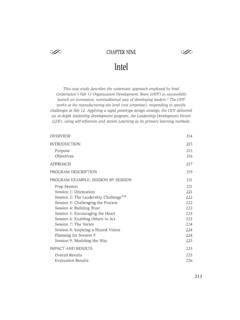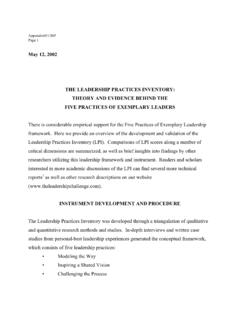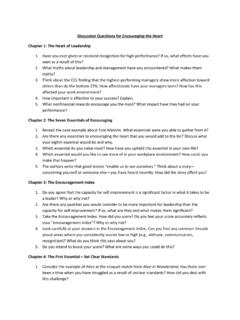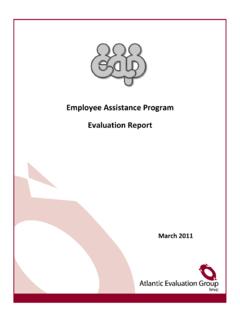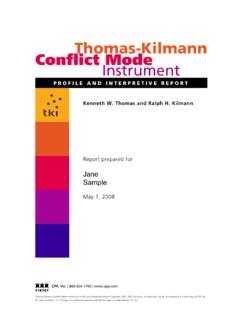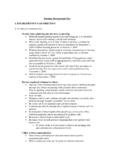Transcription of Leadership Practices Inventory: LPI
1 Leadership PracticesInventory:LPI JAMES M. KOUZES & BARRY Z. POSNERI ndividual feedback ReportPrepared for Amanda Lopez|February 22, 2013 LPI Sample ReportCONTENTSThe Five Practices of Exemplary Leadership and the LPI report .. 1 The Five Practices Data Summary .. 2 The Five Practices Bar Graphs .. 3 Leadership Behaviors Ranking .. 4 Model the Way Data Summary .. 6 Model the Way Bar Graphs .. 7 Inspire a Shared Vision Data Summary .. 8 Inspire a Shared Vision Bar Graphs .. 9 Challenge the Process Data Summary .. 10 Challenge the Process Bar Graphs .. 11 Enable Others to Act Data Summary .. 12 Enable Others to Act Bar Graphs .. 13 Encourage the Heart Data Summary .. 14 Encourage the Heart Bar Graphs .. 15 Percentile Ranking .. 16 The Five Practices of Exemplary Leadership Created by James M.
2 Kouzes and Barry Z. Posner in the early 1980s and first identified in their internationally best-selling book,TheLeadership Challenge, The Five Practices of Exemplary Leadership approaches Leadership as a measurable, learnable, and teachableset of behaviors. After conducting hundreds of interviews, reviewing thousands of case studies, and analyzing more than two millionsurvey questionnaires to understand those times when leaders performed at their personal best, there emerged five Practices commonto making extraordinary things happen. The Five Practices are:The Leadership Practices inventory (LPI) instrument is an essential tool to help you gain perspective into how you see yourself as aleader, how others view you, and what actions you can take to improve your use of The Five Practices , which research hasdemonstrated, year after year, make for more effective YOUR LPI REPORTThe LPI measures the frequency of 30 specific Leadership behaviors on a 10-point scale, with six behavioral statements for each of TheFive Practices .
3 You and the observers you selected rated how frequently you engage in each of these important behaviors associatedwith The Five Practices . The response scale is:1-Almost Never3-Seldom5-Occasionally7-Fairly Often9-Very FrequentlyRESPONSE SCALE2-Rarely4-Once in a While6-Sometimes8-Usually10-Almost alwaysIn the following report pages, you'll see your LPI Self (S) responses and your observer responses, which are categorized into Manager(M), Direct report (D), Co-Worker (C), and Other (O). Observer responses are categorized as "Other" when there are not enoughresponses in the Direct report or Coworker categories to preserve observer anonymity. The average observer rating (AVG) is anaverage of all LPI observer responses including ABBREVIATIONS:M-ManagerD-Direct ReportC-Co-WorkerO-OtherS-SelfAVG-Averag e of all Observer ResponsesYou requested a total of99observers to rate you; of these,99have submitted an Observer survey as of report date and are included inyour report for Amanda LopezSub Folder TestFebruary 22, 2013 Copyright 2013 by James M.
4 Kouzes and Barry Z. Posner. Published by Jossey-Bass. All rights reserved. REPORTThe Five Practices Data SummaryThis page summarizes your LPI responses for each Leadership Practice. The Self column shows the total of your own responses to the sixbehavioral statements about each Practice. The Individual Observers columns show the total of each Observer's six responses for thePractice. The AVG column shows the average of all your Observers' total responses. Total responses for each Practice can range from 6to 60; which represents adding up the response score (ranging from 1-Almost Never to 10-Almost Always) for each of the six behavioralstatements related to that OBSERVERSM1D1D2D3D4C1C2C3O1 Modelthe aShared to ReportC-Co-WorkerO-OtherS-SelfAVG-Averag e of all Observer ResponsesProfile for Amanda LopezSub Folder TestFebruary 22, 2013 Copyright 2013 by James M.
5 Kouzes and Barry Z. Posner. Published by Jossey-Bass. All rights reserved. REPORTThe Five Practices Bar GraphsThese bar graphs, one set for each Leadership Practice, provide a graphic representation of the numerical data recorded on The FivePractices Data Summary page. By Practice, it shows the total response for Self and the average total for each category of refers to the average for all categories of Observers (including Manager). Total responses can range from 6 to 60; whichrepresents adding up the response score (ranging from 1-Almost Never to 10-Almost Always) for each of the six behavioral statementsrelated to that the a Shared the Others to the for Amanda LopezSub Folder TestFebruary 22, 2013 Copyright 2013 by James M.
6 Kouzes and Barry Z. Posner. Published by Jossey-Bass. All rights reserved. REPORTL eadership Behaviors RankingThe following page shows the ranking, from most frequent to least frequent, of all 30 Leadership behaviors based on the average ofyour Observers responses. The average (AVG) includes the Manager response, which is also shown separately. Horizontal linesseparate the 10 most and the 10 least frequent behaviors from the middle 10. A plus sign (+) next to the AVG or Manager (M) responseindicates that the response is more than points higher than your Self response; a minus sign (-) indicates that the response is morethan points lower than your Self response. Since is approximately the average difference between self and observer scores, anydifference greater than that merits attention.
7 When the +/- column is blank in a given row, this indicates a reasonable degree ofagreement between the SELF and AVG or SELF and MANAGER scores. The response scale runs from 1-Almost Never to for Amanda LopezSub Folder TestFebruary 22, 2013 Copyright 2013 by James M. Kouzes and Barry Z. Posner. Published by Jossey-Bass. All rights reserved. REPORTMOST FREQUENTPRACTICESELFAVG +/-M + others with dignity and through on promises and commitments he/she out challenging opportunities that test his/her own skills and a personal example of what he/she expects of about future trends that will influence how our work gets certain that we set achievable goals, make concrete plans, and establishmeasurable milestones for the projects and programs that we work and takes risks.
8 Even when there is a chance of cooperative relationships among the people he/she works listens to diverse points of outside the formal boundaries of his/her organization for innovative ways toimprove what we people a great deal of freedom and choice in deciding how to do their time and energy making certain that the people he/she works with adhere tothe principles and standards that we have agreed people to try out new and innovative ways to do their the decisions that people make on their the "big picture" of what we aspire to + + a compelling image of what our future could be clear about his/her philosophy of consensus around a common set of values for running our the members of the team lots of appreciation and support for their "What can we learn?
9 " when things don't go as others how their long-term interests can be realized by enlisting in a with genuine conviction about the higher meaning and purpose of our people for a job well + sure that people are creatively rewarded for their contributions to the success + + it a point to let people know about his/her confidence in their that people grow in their jobs by learning new skills and to others to share an exciting dream of the recognizes people who exemplify commitment to shared + ways to celebrate + for feedback on how his/her actions affect other people's FREQUENTP rofile for Amanda LopezSub Folder TestFebruary 22, 2013 Copyright 2013 by James M. Kouzes and Barry Z. Posner. Published by Jossey-Bass. All rights reserved.
10 REPORTC larify values by finding your voice and affirming shared valuesThis page shows the responses for each of the six Leadership behaviors related to this Practice. The Self column shows the responsesyou gave yourself for each behavior. The AVG column shows the averages of the Observers responses. The Individual Observerscolumns show each Observers response for each behavioral item. Responses can range from 1-Almost Never to 10-Almost the Way Data SummarySet the example by aligning actions with shared valuesSELFAVGINDIVIDUAL a personal example ofwhat he/she expects of time and energymaking certain that the peoplehe/she works with adhere tothe principles and standardsthat we have agreed through on promisesand commitments for feedback on how his/her actions affect otherpeople's consensus around acommon set of values forrunning our clear about his/herphilosophy of Never3-Seldom5-Occasionally7-Fairly Often9-Very FrequentlyRESPONSE SCALE2-Rarely4-Once in a While6-Sometimes8-Usually10-Almost alwaysM-ManagerD-Direct ReportC-Co-WorkerO-OtherS-SelfAVG-Averag e of all Observer ResponsesProfile for Amanda LopezSub

